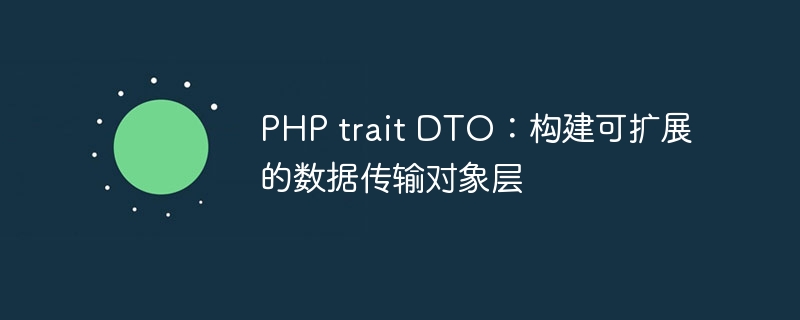

PHP trait DTO: Building a scalable Data Transfer Object Layer
As web applications increase in complexity and size, the need for Data Transfer Objects (DTOs) Concepts become increasingly important. DTOs are objects used to encapsulate and transfer data, typically for data exchange between different layers of an application. In this article, we will discuss using PHP traits to build extensible DTO layers for code reuse and flexibility.
What is the DTO pattern?
The DTO pattern is a design pattern that allows data to be transferred from one layer to another while encapsulating the structure and access of the data. DTO objects are often used to transfer data across layers, such as from the database layer to the business logic layer, or from the business logic layer to the presentation layer (such as API responses). By using the DTO pattern, we can achieve a unified format and structure of data while isolating changes in the underlying implementation.
Why use traits?
In PHP, trait is a mechanism to solve the problem of multiple inheritance. It allows us to share code without inheritance. Using traits to build the DTO layer has the following advantages:
Building an extensible DTO layer
The following is an example that demonstrates how to use PHP traits to build an extensible DTO layer. Let's assume there is a DTO object named User, which has two properties: id and name.
trait IdTrait {
protected $id;
public function getId() {
return $this->id;
}
public function setId($id) {
$this->id = $id;
}
}
trait NameTrait {
protected $name;
public function getName() {
return $this->name;
}
public function setName($name) {
$this->name = $name;
}
}
class User {
use IdTrait, NameTrait;
// 具体的业务逻辑
}In the above example, we defined two traits: IdTrait and NameTrait. These two traits encapsulate the obtaining and setting methods of the id and name attributes respectively. Next, we created a User class and introduced these two traits using the use keyword.
Now, we can create a User object and get the corresponding attribute values using the getId() and getName() methods. At the same time, we can also use the setId() and setName() methods to set attribute values. In this way, we can reuse these methods in different User objects to achieve code reuse and flexibility.
Summary
Using PHP traits can effectively build extensible DTO layers. By encapsulating DTO logic in traits, we can achieve code reuse and flexibility. Each DTO object can selectively reference different traits to meet different business needs. This flexibility enables the DTO layer to adapt to different business scenarios while keeping the code clear and maintainable.
When we build large-scale web applications, consider using PHP traits to build extensible DTO layers to improve code maintainability and flexibility.
The above is the detailed content of PHP trait DTO: Building an extensible data transfer object layer. For more information, please follow other related articles on the PHP Chinese website!




